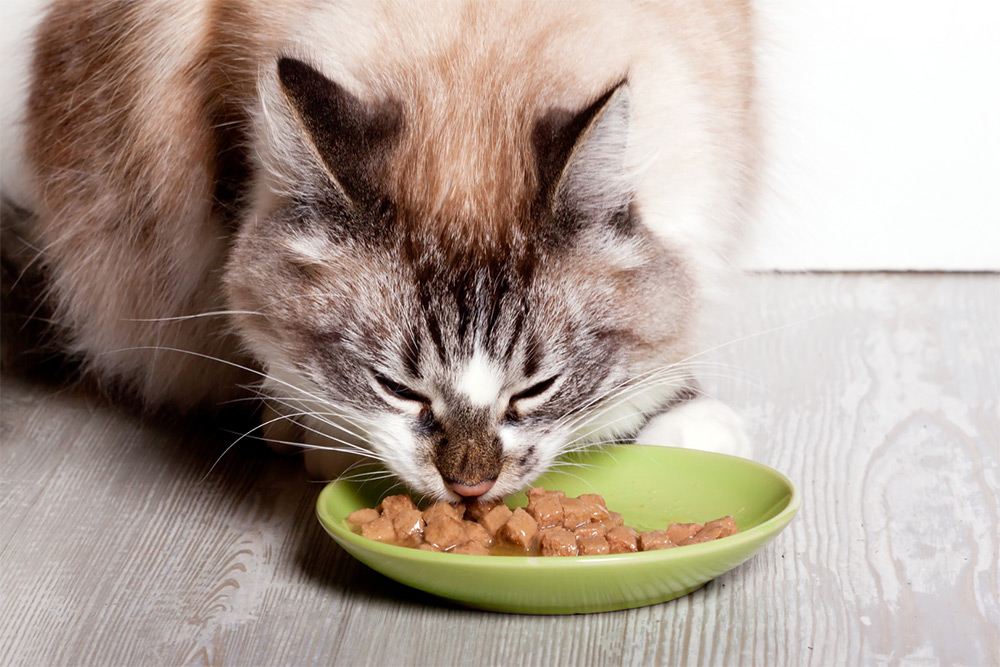Is it Time To Switch My Feline’s Food?
May 5th, 2021

Paying attention to your feline friend’s nutrition will contribute to a longer, healthier life. But did you know that with time, your cat’s needs change, and you’ll need to accommodate for these changes by switching foods? Learn all about the signs that it’s time to move on to a different diet.
Life Stage Feeding Requirements
Your trusted team at All About Cats Veterinary Hospital is happy to offer tips and recommendations about the best cat food choices based on your fur-ever friend’s unique needs during each stage of life. In general, we recommend a wet food diet over a dry food diet, as wet food is more beneficial to a cat’s overall and long-term health.
Kitten: During this stage, from weaning to about one year old, your kitty’s food is designed to meet the growth requirements by providing a higher protein content and calorie count. Otherwise, you risk complications, including problems with growth or illness. Choose a wet food that is labeled as a kitten diet.
Adult: During the adult phase, from about one year old to ten years old, depending on the cat, obesity is one thing to look out for. Make sure you select nutritious and high-quality feline food, taking into account your cat’s activity level and lifestyle.
Senior: Medical issues often surface during the senior life stage, about eleven plus years old; dietary changes may be necessary. For example, mobility issues call for foods that contain glucosamine and fatty acids such as DHA and EPA. There are also foods specific to cats with chronic kidney disease, heart disease, diabetes, urinary disease, and obesity.
Other Signs It’s Time to Change Your Cat’s Food
While most cats will require food changes during life stage transitions, there are additional signs you’ll need to note that may indicate it’s time for a switch. These include a dull or flaky coat, lethargy or weakness, obesity, gastrointestinal disturbances, food allergies, or specific health conditions.
Transitioning Your Feline Friend to the New Food
Transitioning your cat to the new food is a process. Switching too quickly can result in gastrointestinal upset, including diarrhea and vomiting. So what’s the best way to switch to the new food? The most important thing is to avoid any abrupt changes and to make a gradual transition. Think seven days. On the first day, use a mix of primarily current food with a little bit of the new food. On each following day, add a little more of the new and take out more of the old until you fully transition to the new food. Once the switch is complete, monitor your kitty to ensure no changes in behavior, health, or appearance develop. If they do, make sure to visit All About Cats Veterinary Hospital to determine a better food option.
When Is it Time to Visit the Vet?
If you notice a change in your furry friend’s hunger level, including a decrease or dramatic increase in appetite, it’s best to determine the underlying causes of the eating issues. Don’t simply switch foods or overcompensate with treats.
Talk to Your Trusted Veterinarians
Visit All About Cats Veterinary Hospital in Kirkland, WA, to learn more about healthy cat nutrition for a long and healthy life. We are happy to make food recommendations based on your four-legged companion’s unique needs. You can always count on us for paw-some feline care because, after all, we are all about cats!
Recent Posts
-
Summer Safety Tips for Cat Owners
July 11th, 2024
-
The ABCs of Cat Vaccinations – What Every Cat Owner Should Know
June 5th, 2024
-
Preparing for Travel With or Without Your Feline Friend
May 3rd, 2024
-
How to Feed Cats in a Multiple-Cat Household
April 8th, 2024
-
8 Tips to Get Your Cat in a Carrier
March 5th, 2024
-
Help, My Cat’s Breath Smells!
February 5th, 2024
-
A Quick Guide to Coping with Cat Emergencies
January 8th, 2024
-
Traveling for the Holidays? 6 Things to Do Before Leaving Your Cat
December 14th, 2023
-
What Is Catnip and Is It Safe for Your Cat?
November 2nd, 2023
-
5 Tips for New Cat Owners
October 5th, 2023
-
How Often Should My Cat Have a Health Check?
September 7th, 2023
-
Cat Hairballs – What Do I Need to Know?
August 4th, 2023
-
How to Play with Your Cat: Fun Cat Activities
July 4th, 2023
-
What to Know About Your Cat’s Surgery
June 10th, 2023
-
Licensed Veterinary Technician or Technician Assistant Wanted (Full time or Part time)
May 15th, 2023
-
Why, Oh Why, Does My Cat Hate Water?
May 9th, 2023
-
What’s Wrong with My Cat? Benefits of Whole-Body Radiology
April 5th, 2023
-
Should I Feed My Cat a Grain-Free Diet?
March 6th, 2023
-
Smelly Cat, Smelly Cat – Causes of Feline Odors
February 22nd, 2023
-
5 Ways to Reduce Cat Shedding
January 3rd, 2023
-
Your Cat’s Holiday Stress – How to Help
December 6th, 2022
-
Pet Cancer Awareness Month: Warning Signs to Look Out For
November 2nd, 2022
-
10 Halloween Safety Tips for Cat Owners
October 3rd, 2022
-
Why Is My Cat So Active at Night?
September 7th, 2022
-
Should I Really Microchip My Cat?
August 9th, 2022
-
Ways to Keep Your Cat Safe and Cool This Summer
July 1st, 2022
-
10 Fascinating Facts About Persian Cats
June 1st, 2022
-
How to Correctly Transition Cat Foods
May 6th, 2022
-
What Your Cat’s Tail Is Secretly Trying to Tell You
April 5th, 2022
-
6 Common Household Items That Are Poisonous to Cats
March 1st, 2022
-
How Do I Know if My Cat Needs Dental Surgery?
February 16th, 2022
-
How to Safely Introduce Your Cat to Your New Baby
January 11th, 2022
-
Giving a Cat as a Christmas Gift: How to Do It Responsibly
December 6th, 2021
-
5 Thanksgiving Foods That Are Toxic to Cats
November 5th, 2021
-
Is My Kitty Depressed? Signs to Look For in a Sad Cat
October 7th, 2021
-
Training Tips for New Kitten Owners
September 7th, 2021
-
Taking Your Cat to the Vet: How to Make It a Stress-Free Experience
August 6th, 2021
-
The Origins and History of the Tabby Cat
July 13th, 2021
-
We are hiring a Veterinary Technician!
July 12th, 2021
-
Kitty Claw Control: How and When to Cut Your Cat’s Nails
June 7th, 2021














